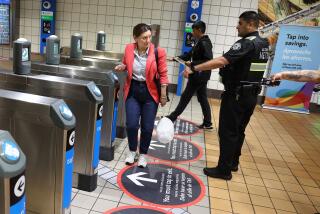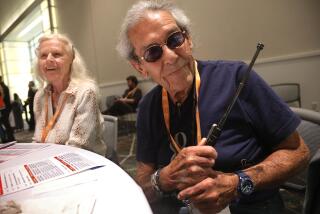Traveling in Big Cities Where Tires Fear to Tread
- Share via
“Should I take my car to Boston?” my friend asked.
I hesitated. “Well, maybe, if you want to drive across the country and see the country.”
But then I thought about trying to drive in downtown Boston and shuddered. “No, don’t take your car,” I said. “Traffic is too jammed.”
“Worse than L.A.?” She seemed surprised.
I thought of Boston’s paved-over cow paths jammed with oxcarts and mule-powered freight wagons. (Truthfully, there are no oxcarts or mules; it just seems that congested.) In Los Angeles, during the off-hours at least, it is still possible to get around efficiently, to find clear sailing some of the time on some of the freeways.
“Worse than L.A.,” I assured her. “Everything is concentrated downtown. In the big cities in the East, everything is packed into downtown.”
My friend, who was heading to Boston for a summer program at Harvard, seemed impressed.
Leave Driving to Them
In the East, I told her, they have public transportation, and people actually use it. It’s so easy to get around in a big city that you wouldn’t want to bother with a car. In Boston especially, I said, the subways and buses are great.
“I won’t take my car,” she decided.
On my most recent visit to Boston, I did in fact drive into the city, but only to the hotel. My wife and I put the car in the hotel garage at the Prudential Center and left it there until we were ready to leave town. Like Paul Revere, we kept our horse in the stable until we were ready to ride out to Lexington and Concord.
The subway, we found, stopped right at the Prudential Center. In five minutes we were downtown. A transfer to the Red Line, and it was another short trip out to Harvard. A car? Don’t be ridiculous.
Boston, like other Eastern cities, also is a good town for walking. A pleasant stroll from the Prudential Center takes you to the Charles River and, if you wish, you can jog back and pretend you are finishing the Boston Marathon. (The course ends at the Prudential Center.)
Hotels at Copley Square are closer to downtown, but it’s also possible to walk there from the Prudential Center, as my wife and I did on a sunny day, crossing Boston Common on our way to lunch at “the cradle of liberty,” Faneuil Hall.
It should be kept in mind that in the big cities of America, walking and subway riding are best done in the light of day, in areas known to be relatively safe. Visitors should use caution in venturing into unfamiliar territory.
For many non-urbanites, however, going into a city on public transportation is unthinkable, unsafe at any speed. If they can’t drive there and park there, they don’t want to go. And the thought of going down into a subway? Forget it.
When I visited New York with Connecticut relatives a couple of years ago I dashed ahead to the subway station to buy a pocketful of tokens, enough to accommodate all hands. My relatives, to my surprise, were hurt and angry--momentarily terrified that I was leaving them in the deepest Bronx, never to be seen again except for their pictures on milk cartons.
Public transportation that day--the Fourth of July--was virtually the only means of getting into the city. Manhattan was blocked off to vehicular traffic, so we drove into the Riverdale section of the Bronx and caught the west side (IRT) subway at the end of the line. That took us out of the Bronx and across the river into upper Manhattan.
After a hearty sandwich and a glass of beer at the West End Cafe, Columbia University’s popular haunt, our relatives’ nerves were becalmed and we strolled down through Riverside Park and across the West Side Highway (which was closed for the day) to the edge of the Hudson, where we joined the crowd watching the parade of the Tall Ships.
Later we returned to the same subway and resumed our ride to the other end of the line, at Battery Park, opposite the great statue and the center of much of the day’s activity.
After the fireworks we retraced our subway route, retrieved our car from a well-lighted public parking area and made good our escape to Connecticut (a trip that, on Westchester County’s narrow freeways, seemed a good deal more dangerous than the subway).
One problem that a visitor to the East frequently encounters is rain, and that can restrict the traveler’s enthusiasm for waiting at a bus stop or walking five blocks to the nearest subway station.
Rainy Departure
On my most recent encounter with the moist East, in late May for a college graduation in Philadelphia, a group of nine of us had planned to take the subway down Broad Street to the Spectrum, scene of the ceremonies. But at departure time, buckets of rain were pouring down, enough to soak anyone within three steps out the door.
Fortunately our doorman at the Barclay on Rittenhouse Square was able to summon a cab, and we were on our way reasonably dry, while others in our party followed in a second cab.
The commencement concluded, and it was a different story. This time there seemed to be no cabs to hail.
By then the rain had slowed to a drizzle. We walked to the nearby subway station and paid $1.25 each, arrived on the platform to find a train waiting and were back downtown for lunch in little more than 10 minutes.
Rain imposes solutions, but at other times, economics can be a factor. Philadelphia’s $1.25 bus and subway fare may be the highest in the nation. For the lone traveler, a bus or subway ride might be economical. But the fare for five people comes close to the fee for a taxi, maybe even including the tip.
Bus and subway fares in New York are $1. In Boston you can ride anywhere in the subway system for 60 cents; on buses the fare is only 50 cents. It’s one of the best deals anywhere.
In Washington, Metrorail (the best and brightest of public transit in the East) adjusts its fares to the distance traveled and to the time of day; you buy a ticket from a vending machine before departure. For a ride from National Airport to Union Station the price is 80 cents; that goes up to $1 during rush hour.
Last year, after driving around Virginia and the Washington area for a week, I was most relieved to turn in our rental car. I was batting 100% on wrong turns, so I chose public transport.
A jitney from the rental car agency took us into National Airport and the Metro. We lugged our suitcases up the steps to the train, a mild workout. In retrospect, a cab might have been a better choice.
Downtown in the middle of the day we easily accomplished a transfer from the airport line (blue) to the Union Station line (red). Transfers are made at Metro Center, the subway stop at 12th and G streets. Metrorail took us directly into Union Station where, after a short wait, we caught a train for New York, a far better choice, I thought, than driving a rental car into Manhattan.
Perhaps my favorite mode of public transportation (with the possible exception of the San Francisco cable car) is the electric-powered Philadelphia trolley. On most of the city’s routes conventional buses have replaced trolleys for the sake of maneuverability.
When a trolley breaks down it doesn’t pull over to the side of the road to let other traffic pass, it just sits there--immobile, hitched to the overhead power line, its wheels firmly planted on its tracks. Until it is repaired, no other trolley can pass.
Trolleys Still Survive
On our recent Philadelphia visit we caught a still-surviving trolley, not to go anywhere in particular but just to take a ride before the last one rolls into a museum one of these days.
We climbed aboard in Center City, and the trolley soon whisked us into South Philadelphia, hometown of Frank Rizzo, Rocky and cheese steaks.
I’ve always been fascinated by the Italian neighborhoods of South Philadelphia, and our ride took us down the narrow streets between neat, tightly packed row houses with their flower-filled windows.
At the end of line, within sight (and a reasonable walk, if you want) of Veterans Stadium, the trolley does its turnaround, making a loop from 12th Street to 11th Street for the return. The driver assured us that did not entail a second fare.
We headed back, returning as far as 11th and Washington. There we got off and walked two blocks to the Italian Market, where we stopped for coffee and Italian pastry.
We could have returned to the trolley but instead, it being a sunny Saturday afternoon, we walked back to Center City. The cheery clang of a trolley greeted us again as we crossed its path on the way back to our hotel--the hotel that would have charged us $13 a night to park our car, if we had brought one.
More to Read
Sign up for The Wild
We’ll help you find the best places to hike, bike and run, as well as the perfect silent spots for meditation and yoga.
You may occasionally receive promotional content from the Los Angeles Times.






